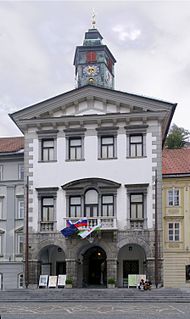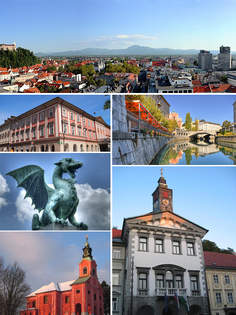
Prešeren Square is the central square in Ljubljana, the capital of Slovenia. It is part of the old town's pedestrian zone and a major meeting point, where festivals, Ljubljana carnival, concerts, sports, political, and protest events take place. It was renovated in 2007.

Zoran Janković is a Slovene businessman and politician. He came to prominence in 1997 as the president of the Slovenian retail company Mercator. From October 2006 to December 2011, he was mayor of Ljubljana, the capital of Slovenia. In October 2011, he established the Positive Slovenia party, which won the plurality of votes at the early Slovenian 2011 parliamentary election. His function as a mayor ceased on 21 December 2011, when he became a deputy in the National Assembly. After he failed to be elected as the prime minister in the National Assembly, he was re-elected as the mayor of Ljubljana and retook the position on 11 April 2012. He is the first mayor of Ljubljana to have served two terms since the end of World War II.

Dane Zajc was a Slovenian poet and playwright. He served as president of the Slovene Writers' Association (1991–1995), and was awarded the prestigious Prešeren Award for lifetime achievement (1981). Together with Edvard Kocbek and Gregor Strniša, he is considered as the most important Slovenian poet of the second half of the 20th century.

Ljubljana Town Hall is the town hall in Ljubljana, the capital of Slovenia, is the seat of the City Municipality of Ljubljana. It is located at Town Square in the city centre close to Ljubljana Cathedral.

Ljubljana Cathedral, officially named St. Nicholas's Church, also named St. Nicholas' Cathedral, the Cathedral of St. Nicholas, or simply the Cathedral, is a cathedral in Ljubljana, the capital of Slovenia. Originally, Ljubljana Cathedral was a Gothic church. In the early 18th century, it was replaced by a Baroque building. It is an easily recognizable landmark of the city with its green dome and twin towers and stands at Cyril and Methodius Square by the nearby Ljubljana Central Market and Town Hall.

The Robba Fountain, since the first half of the 20th century also known as the Fountain of the Three Carniolan Rivers, is the fountain that stands in front of Ljubljana Town Hall at Town Square in Ljubljana, the capital of Slovenia. It was originally made in 1751 by the Italian sculptor Francesco Robba and is one of the city's most recognisable symbols.

St. Peter's Parish Church is a Roman Catholic church in Ljubljana, the capital of Slovenia. It is one of the oldest churches in Ljubljana and is the seat of Ljubljana–St. Peter parish. It is located in the Center District, at the corner of Trubar Street, Njegoš Street and Zalog Street, near Croatian Square. The University Medical Centre Ljubljana is situated in the immediate vicinity.

Cekin Mansion is a mansion on the northern edge of Tivoli Park in Ljubljana, the capital of Slovenia. It is located next to Tivoli Hall in the Šiška District. It houses the Museum of Contemporary History of Slovenia.

St. Peter's Bridge, also Ambrož Bridge, is a bridge in Ljubljana, the capital of Slovenia, that crosses the river Ljubljanica in the northeastern end of the old town. It is a continuation of Rozman Street. West of it lie Vraz Square on the northern (left) bank of the river and Ambrož Square on its southern (right) bank. East of it lies the Petkovšek Embankment on the northern bank and the Poljane Embankment on the southern bank. The bridge is named after the nearby St. Peter's Church. It is intended primarily for motorised traffic, but is also used by pedestrians.
Gregor Tomc also known as Grega Tomc is a Slovenian sociologist, musician and activist. In the late 1970s and 1980s, he was the founder and member of the Slovenian punk rock band Pankrti.
Janez Lantheri was a Slovenian politician of the early 16th century. He became mayor of Ljubljana in 1504. He was succeeded by Gregor Lagner in 1505.
Kristof Otto was a politician of the 17th century in Slovenia when the country was under the Holy Roman Empire. He became mayor of Ljubljana in 1634. He was succeeded by Gregor Khunstl in 1638.
Gregor Khunstl was a politician of the 17th century in Slovenia when the country was under the Holy Roman Empire. He became mayor of Ljubljana in 1638. He was succeeded by Marko Wiz in 1640.

Gregor Žerjav, sometimes spelled Žerjal, was a Slovene and Yugoslav lawyer and liberal politician. Together with Albert Kramer, he was the leader of the Slovenian liberals in the Kingdom of Serbs, Croats and Slovenes.
Gregor Strniša was a Slovenian poet, playwright, and songwriter. He is considered one of the most important Slovene-language poet of the second half of the 20th century. He spent most of his life away from public light, and has gained widespread recognition only after his death.

The Ljubljana Central Market in the capital of Slovenia was designed by Jože Plečnik in 1931–39. The market building stretches between the Triple Bridge and the Dragon Bridge, on the right side of the curve of the Ljubljanica River. The market and Vodnik Square, which it is located at, are cultural monuments of national significance. It is partly situated at Adamič–Lunder Embankment and at Pogačar Square.

The Križanke Outdoor Theatre is a theatre in Ljubljana, Slovenia, used for summer festivals set up inside the courtyard of the former Monastery of the Holy Cross. It is located at French Revolution Square no. 1.

The Ljubljana Botanical Garden, officially the University of Ljubljana Botanical Garden, is the central Slovenian botanical garden, the oldest botanical garden in Southeastern Europe, and one of the oldest cultural, scientific, and educational organisations in Slovenia. Its headquarters are located in the Rudnik District of Ljubljana, the Slovenian capital, at Ig Street along the Gruber Canal to the southeast of Castle Hill. The garden started operating under the leadership of Franc Hladnik in 1810, when Ljubljana was the capital of the Illyrian Provinces. It is thus an averagely old European botanical garden. The institution is a member of the international network Botanic Gardens Conservation International and cooperates with more than 270 botanical gardens all across the world. Of over 4,500 plant species and subspecies that grow on 2 hectares, roughly a third is endemic to Slovenia, whereas the rest originate from other European places and other continents.














